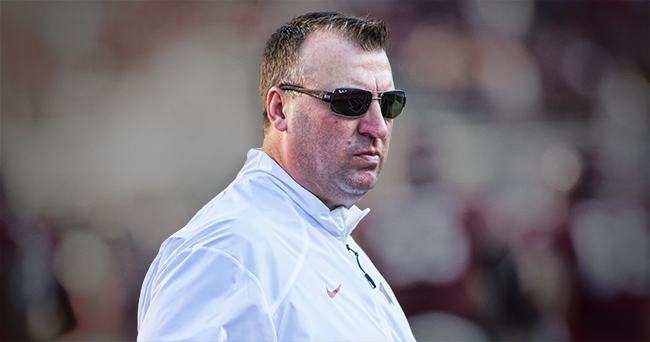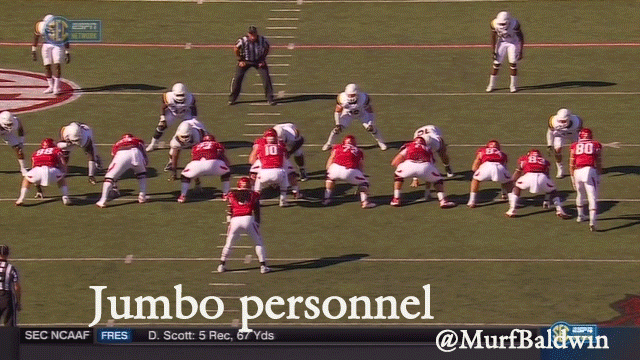
Film Study: Arkansas will be fine once it gets back to its core physicality
After months and months of speculation, first starting with my detailed breakdown of new University of Arkansas offensive coordinator Dan Enos and how his scheme was deployed at previous stops, and ending with how I believed its rushing attack would thrive despite the loss of potential All-American running back Jonathan Williams, I finally got the chance to get down to the brass tacks of the matter of seeing how the Hogs’ offense would actually take shape in a year where the Southeastern Conference seems to be as wide-open as the Autobahn in Germany.
Quick recap: The Razorbacks made an undoubted improvement on the offensive side of the ball behind former OC Jim Chaney who evolved his style from more of a spread-oriented attack centered around multiple receivers, to one based, at least conceptually, in multi-tight sets geared toward cranking out yardage — in an extremely physical manner — in the between-the-tackles run game.
As effective as Chaney’s scheme was, and keep in mind the improvement he helped architect with then-junior quarterback Brandon Allen, many felt as though his game plans left a lot to be desired in certain core areas: vertical concepts and the screen game.
Fast forward to the acquisition of Enos — who left his post as the head man at Central Michigan University to scheme it up for a coach who expects nothing less than to drill the opposition into a coma via physical play in Bret Bielema — I felt proud of uncovering how he was brought in primarily for scheme continuity.
And I was right; the operative word being was.
Bielema had me giddy like a little schoolgirl with multiple quotes on how any scheme ran by his team has his fingerprints all over it. He said he loved Enos because “watching Central Michigan was like looking in the mirror.”
I bit that hook, line and sinker.
Coach Bielema’s appeal to me ran deep, as his scheme was one of the first I studied from pillar to post since before I was still playing football here in the state of Georgia (semi-professionally). His offenses at the University of Wisconsin were so rugged that even a defensive player such as myself had to take notice.
And when I declared late last season that you “Better beat Arkansas while you can,” it was under the assumption that Arkansas would stick to its core beliefs and get better at being the biggest bully on the block. But then something changed: Arkansas became the darling of the offseason once the rest of the media started looking for storylines. Sure, back-to-back wins over LSU and Ole Miss was something to hang your hat on, but beating the lowly University of Texas in the Texas Bowl was about as insignificant as it gets.
But the groundswell of support grew so much that Arkansas went from having a great shot to improve on last season’s record, to being touted for a spot in the College Football Playoffs by a grip of notable media type. But I did my best to temper the expectations as I felt like the Razorbacks were a couple of seasons away from being talented enough to compete on a weekly basis with the upper echelon of college football. On countless radio appearances throughout the state — and other media platforms I’m not allowed to mention (haha) — I tried to relay my belief that the Hogs were working with too many unknown factors to be automatically favored over teams like LSU, Ole Miss, Texas A&M and other teams the Arkansas media felt were inferior.
While I said the Hogs could compete with anyone on the schedule, I also said that anyone on the schedule could compete with them, too. But it was too late; the train left the station. I may have heard the Hogs have the “largest offensive line in football” about a million times. Please tell me what does having the largest offensive line in football has to do with the price of tea in China? That same line struggled quite a bit on short-yardage situations and in games against stout fronts. (The University of Georgia has the smallest offensive line in the country and may have the best run game in college football.)
But when the season was opened with a 48-13 win over the University of Texas El Paso, with Allen collecting player of the week honors for the conference behind a dazzling 308-yard, four-touchdown performance, by all accounts the Hogs’ debut with Enos was a smashing success. But I had to redact that previous adjective, as there was nothing “smashing” about it.
The throw game looked darn good! Allen was going vertical to receivers Keon Hatcher and Jared Cornelius like nobody’s business, and I loved how Enos implemented tight ends Hunter Henry and Jeremy Sprinkle in the offense by getting them out in a ton of space on underneath drags and things of the sort.
But the running game looked as if it were stuck in the mud. Sure, 182 yards on 32 attempts (17 yards per completion!) seems good to those of us that are stat gawkers, but if you watched the contest you would know that it looked elementary at best — save for a 70-yard run by Collins to close the half. A quick study of the scheme revealed advanced concepts in the run game but a legit lack of commitment to further run principles despite the loss of, perhaps, the best player on the team, Williams.
That’s why I expected a bludgeoning of the Toledo Rockets in the second game as I was sure Bielema would want to get back to basics before encountering better opponent as the schedule unfolded. But once again I was severely disappointed; the defense proved to be pretty physical, but the offense went right back to being more finesse. Passing the ball all over the yard doesn’t allow your line to generate a rhythm by playing forward, and it doesn’t remotely soften up the defense.
Allen threw the ball an astounding 53 times (!) and collected 412 yards in the process — completing 60.4 percent of his passes. But he failed to throw a TD and even turned the ball over, uncharacteristically, further putting his team behind the eight ball. And although I like the new-and-improved “B.A.,” I love the “game manager” version even more as that means the Hogs are using their opponents as fertilizer in the run game.
But there was nothing “fertilizery” (is that a word?) about a 31-carry, 103-yard performance in the run game…as a team! I’d expect that to be a game total for starter Alex Collins, as it would at least show Arkansas forced Toledo to stay honest with its defensive deployment. (Theoretically, with 20 carries for 54 yards, it virtually was Collins’ game total.)
But after some early dazzling, it seems as though the run was just something to do while Enos schemed up some more passing concepts.
Check out this Y-Leak out of “Ace personnel.” This a beautifully designed play as it’s ran with tight splits and appears to be a venture into the “Tosser” series but in actuality is a roll-out pass to a leaking tight end. It seems as though Enos subscribes to the Sean Payton (New Orleans Saints) theory of running the ball: short passes are extensions of the run.
Enos has implemented a ton of “Smoke” concepts designed at getting the ball to receivers who are provided a ton of cushion by defensive backs; Allen has a built-in call to audible to that play whenever the situation presents itself.
Case in point: This “Smoke” was perfectly executed by Allen to Hatcher after a double shift by the TEs made the defense declare its assignments; but that’s not physical, people, and it shouldn’t be counted in the run game category.
Here we see the Hogs in “Ace” lined up with pair left; they even widened the splits by the receivers to provide for more room in the trenches. But runs from these sets often occurred on first down instead of third down like we saw from the Hogs last season. In fact, we used to see runs like this from Arkansas on long-yardage situations on third downs.
Check out how a Toledo 3-technique knifed the gap to stop the G-Lead.
That’s right along the lines of Hogs failing to convert a 4th-and-1 late in first half; the same problem that reared its ugly head quite a few times last season.
But the goals of the season are still in front of you, Arkansas. Rip off wins against A&M, Tennessee, Alabama and Auburn, and I guarantee you nobody will be caring about a measly early season loss to Toledo. But let this loss continue to beat you in the subsequent weeks and my beloved coach will end up being fodder for criticism and laughter alike.
With a renewed commitment to physicality, the Hogs should be all right.





